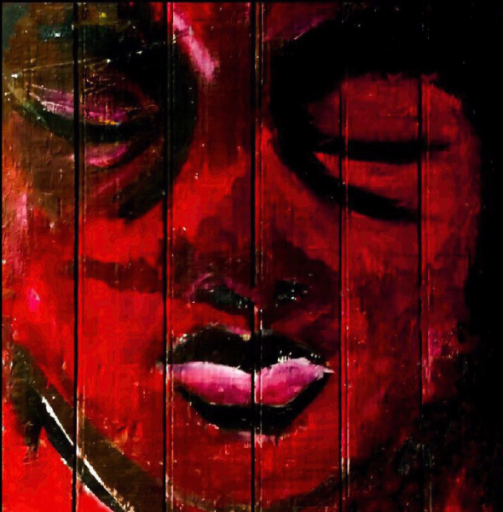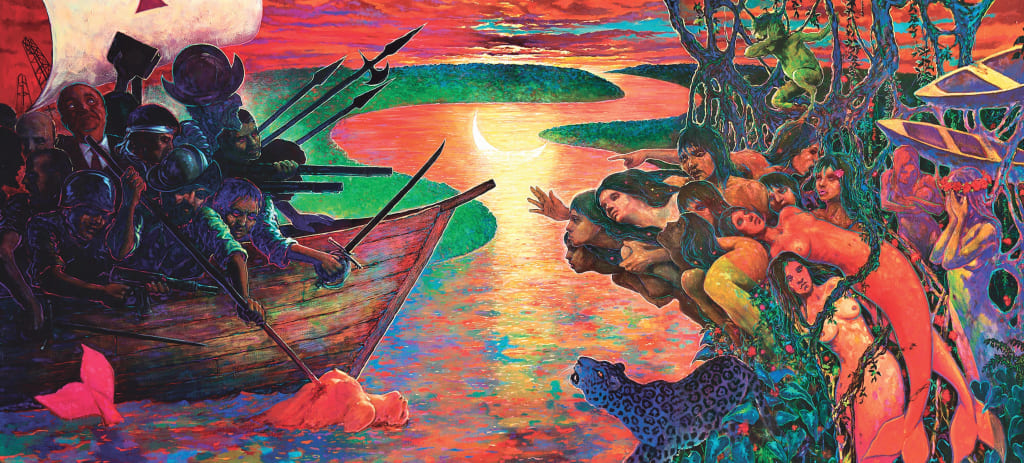Gino Ceccarelli, “El descubrimiento” de la Amazonía.Gino Ceccarelli, “El descubrimiento” de la Amazonía. El choque de dos culturas. Una lucha que evoca tanto la ruptura como la resiliencia.
Arte Amazónico Contemporáneo
Parte 2: Diálogos, Inspiración e Intercambio
en el Arte Amazónico
Existe un diálogo vivo entre el arte indígena amazónico y las diversas formas de expresión artística que se desarrollan en toda la región.
Los patrones tradicionales, los relatos y las mitologías fluyen como fuentes de inspiración hacia distintos lenguajes visuales, encontrando en las obras contemporáneas nuevas formas de expresión.
El arte indígena, a su vez, incorpora recursos y estilos procedentes tanto del arte amazónico urbano como de la escena artística internacional, integrándolos en su propio lenguaje visual. Se trata de un intercambio respetuoso y de una creatividad compartida: un proceso que honra las raíces culturales y, al mismo tiempo, abre nuevas perspectivas.
El tema de la apropiación cultural en el arte amazónico exige una sensibilidad particular, ya que es complejo y multidimensional. Las comunidades indígenas consideran a menudo el uso no autorizado de sus símbolos, mitos y patrones por parte de artistas de otro origen como un acto de despojo o de apropiación ilegítima — una reclamación legítima vinculada a la defensa de su identidad cultural y de su propiedad intelectual.
Al mismo tiempo, el debate sobre la apropiación cultural puede exagerarse y llegar a limitar el intercambio creativo. Históricamente, artistas como Picasso se inspiraron en las formas del arte africano sin que ello invalidara el diálogo artístico en sí mismo.
Lo esencial es una reflexión crítica, que armonice la libertad creativa con la responsabilidad cultural. Un diálogo abierto y respetuoso debe desarrollarse sin prejuicios, para fomentar la comprensión mutua y el reconocimiento justo.
Así, la apropiación cultural puede entenderse como un campo de tensión que desafía a ambas partes: a respetar los límites, pero también a promover conexiones e innovaciones creativas.
Este equilibrio entre respeto, sensibilidad e intercambio creador es fundamental para un arte vivo — en el Amazonas y más allá.
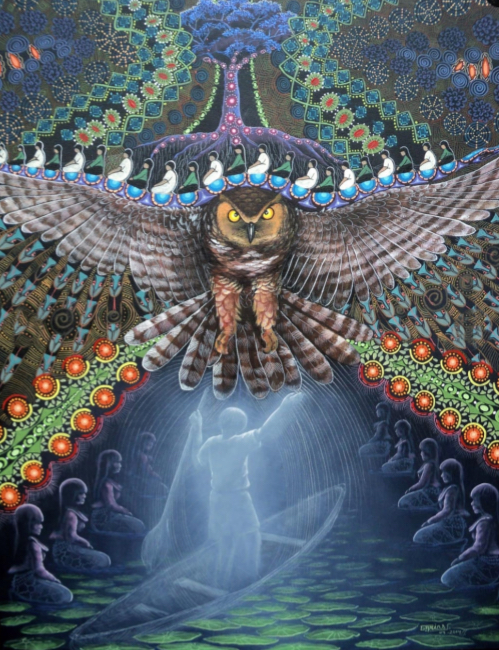
Graciela Arias. „El búho“, símbolo de sabiduría y conocimiento, preside una escena ceremonial donde lo visible y lo invisible convergen — reflejando la exploración de la artista sobre el rito, la memoria y la trascendencia. Arte Amazónico Contemporáneo
Arte indígena y amazónico – hacia una comprensión más profunda
El significado del arte y el impacto que puede tener están íntimamente ligados a la forma en que entendemos el conocimiento: algo que se recoge, se conserva, se narra y se transmite.
La compleja simbología del arte indígena amazónico contemporáneo encarna una cosmovisión en la que todo está interconectado. Lo que existe arriba, en el cielo, se refleja abajo, en la tierra — y viceversa. Los y las artistas no se conciben solo como creadores individuales, sino también como mediadores entre el mundo visible y el invisible.
La creación de una imagen o un objeto no es solo un acto estético, sino también un proceso ritual: una vía para hacer visible el conocimiento espiritual, la memoria colectiva y la continuidad cultural. En este sentido, la pintura indígena suele ser una expresión directa de espiritualidad, saber ancestral, supervivencia comunitaria y elaboración de experiencias compartidas, cuyos significados están profundamente arraigados en una visión del mundo sostenida por la colectividad.
Los artistas indígenas se consideran guardianes de su herencia cultural y mediadores entre la tradición y el presente.
El arte amazónico, por su parte, también refleja la dinámica creativa de un territorio cultural en constante transformación.
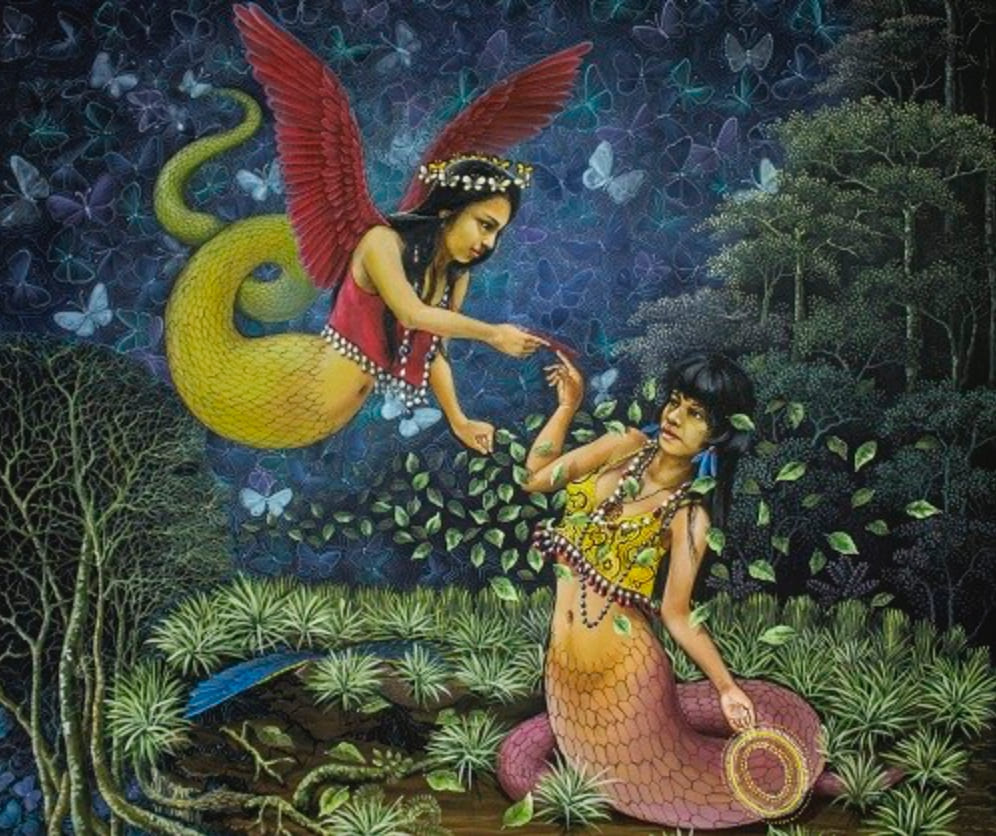
Graciela Arias Salazar – “El Encuentro.” En la profundidad de la selva, dos espíritus se encuentran. Entre ellos fluye un don silencioso — un gesto de conexión entre el mito y la memoria.
La Reinterpretación de lo Sagrado
En muchas obras amazónicas contemporáneas, las dimensiones espirituales y cosmológicas encuentran nuevas formas de expresión a través de artistas que las rearticulan dentro de un contexto moderno.
En lugar de reproducir las formas tradicionales, ofrecen interpretaciones poderosas que revitalizan el conocimiento ancestral mediante la experiencia personal y los lenguajes estéticos contemporáneos.
Mitos, leyendas y relatos heredados son reimaginados: sirven como superficies en las que se proyecta la memoria colectiva y donde se transforman la historia, la identidad, la experiencia y la visión del mundo.
En este proceso, las obras destacan por su intensidad visual, su resonancia emocional y la fuerza de una expresión individual que, sin embargo, permanece profundamente enraizada en la continuidad cultural de la que proviene.
Al mismo tiempo, emerge una voz más personal y, a menudo, introspectiva, que revela la alegría, la sensualidad y el goce de vivir — cualidades esenciales del espíritu amazónico.
Estas obras celebran la sensualidad del instante, la riqueza de las emociones humanas y el ritmo palpitante de la vida en la selva.

Christian Bendayán, Corazón Berraco: herido, expuesto, pero digno. Un corazón que sangra sin esconderse, que transforma su dolor en fuerza.
Desde las profundidades de la selva hasta las luces de la ciudad
Esta vitalidad se refleja en la vida cotidiana de las ciudades: en los mercados, las celebraciones, los bares y todos aquellos espacios donde el pulso del Amazonas se transforma en ritmo urbano. Allí, la vida se manifiesta en intensos contrastes: se celebra y se cuestiona, se muestra y se oculta, en una energía que desborda toda definición.
De esa tensión nace una identidad que se resiste a los límites — contradictoria y exuberante, pero profundamente auténtica. Es un diálogo entre lo antiguo y lo nuevo, entre la pertenencia y la ruptura — una dinámica viva que desafía toda categorización simple.
Ambas corrientes contribuyen, cada una a su manera, a revelar una identidad amazónica inconfundible — una identidad que distingue culturalmente a esta región del resto del país. Muestran que el alma amazónica, profundamente arraigada en su origen, continúa navegando en un mundo moderno y cambiante, reinventándose sin cesar.
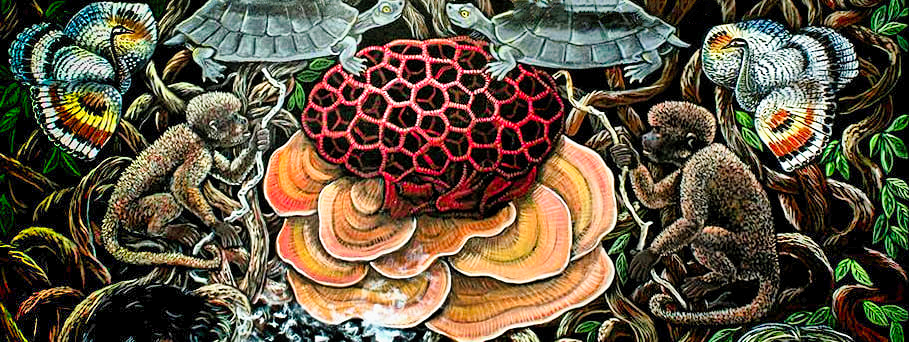
Luis Martínez Dávila transforma la selva en pensamiento, y el pensamiento en color. Arte amazónico, un universo florece desde la raíz.
Raíces Ancestrales y Mitologías Modernas
La experimentación con materiales diversos —desde pigmentos naturales hasta técnicas mixtas que incorporan elementos orgánicos— enriquece aún más estas expresiones.
De este modo, los artistas amazónicos desafían los límites tradicionales del arte visual, integrando referentes culturales y contemporáneos en un lenguaje propio, dinámico y en constante transformación. Así construyen un diálogo entre tradición, memoria y cambio, reflejando tanto la identidad única de la Amazonía como los desafíos sociales y ambientales que enfrenta hoy.
Del paisaje del arte amazónico contemporáneo emerge una vibrante corriente urbana, que fusiona raíces locales con influencias globales y estilos pop. Esta tendencia se caracteriza por el uso audaz de colores neón, que irradian energía y vitalidad, y por una estética cercana al pop art, con referencias visuales que evocan la iconografía de Warhol.
En estas obras, lo mitológico se reinterpreta a través de símbolos cotidianos y motivos aparentemente triviales, creando una iconografía que entrelaza lo ancestral y lo moderno de forma lúdica y crítica. Este lenguaje visual capta la complejidad de la vida urbana amazónica, donde la tradición convive con la cultura popular contemporánea, y donde el mito se resignifica a la luz de la modernidad, dando lugar a una cultura visual audaz, colorida y profundamente humana.
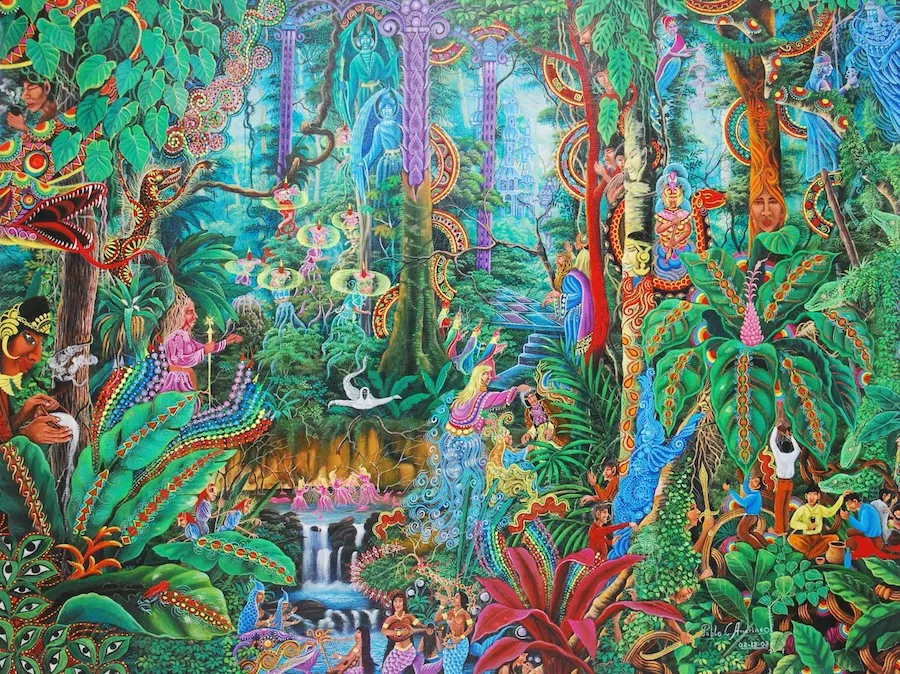
Pablo Amaringo – “Visión Amazónica.” La selva despierta en una armonía radiante — espíritus, curanderos y animales se unen en un canto luminoso de creación, revelando la sinfonía oculta de la selva donde todos los seres están conectados.
Arte Visionario
Aunque el arte visionario no es el foco principal de este ensayo, la corriente merece una mención. Enraizada en la representación de estados alterados de conciencia, dimensiones espirituales y visiones místicas, esta estética comparte ciertas afinidades visuales con las tradiciones amazónicas.
Las obras de Pablo Amaringo son un ejemplo emblemático de esta corriente: nacen de la experiencia vivida, del conocimiento cultural profundo y de la práctica ceremonial. Representan una reinterpretación que une elementos tradicionales del Amazonas con influencias de imaginarios culturales y espirituales contemporáneos.
Sin embargo, gran parte del arte visionario que se comercializa a nivel global en la actualidad reproduce una iconografía psicodélica, a menudo desconectada del contexto cultural y ceremonial que supuestamente representa.
Así surge un misticismo estetizado y comercializado, más centrado en el impacto visual que en la autenticidad o en la profundidad cultural.

Gino Ceccarelli – “Guerrera Amazónica.” Una visión conmovedora de fuerza y resistencia. El rostro emerge, marcado por cicatrices rituales que evocan la memoria y la resiliencia. Gino capta el espíritu de la resistencia, una presencia silenciosa y vigilante que parece custodiar el alma misma de la selva.
Entre paradojas, voces propias y nuevas miradas
En una región marcada por contrastes — entre abandono y belleza, abundancia natural y amenaza constante — el arte se convierte en un espacio de resonancia.
Los artistas no indígenas que habitan la Amazonía crean desde un territorio de paradojas: imponente y vulnerable, pleno de vida y, al mismo tiempo, en peligro.
No hablan en nombre de otros; hablan desde sí mismos, desde su vínculo con la tierra, desde la urgencia de expresar algo propio.
Sus obras no buscan replicar una espiritualidad heredada, sino explorar realidades compartidas: la identidad híbrida, la desigualdad, la memoria afectiva del territorio y la tensión entre tradición y modernidad.
Lo espiritual, lo urbano, lo mitológico y lo político se entrelazan en formas nuevas, intensas, a veces incómodas, pero siempre vivas.
A medida que crece la conciencia global sobre la importancia de la Amazonía, también se amplía el espacio para estas voces.
Son expresiones que no intentan explicar la selva, sino mostrar cómo se vive en ella: cómo se recuerda, cómo se resiste, cómo se lucha… y cómo se sigue adelante, soñando, creando y amando.
El arte amazónico contemporáneo — como la selva misma — no se deja reducir a una sola interpretación: es exceso, mezcla, caos, ritmo y reinvención.
Es un pulso creador que no solo refleja el mundo, sino que también lo desafía, lo transforma y lo invita a ser visto desde nuevas perspectivas.
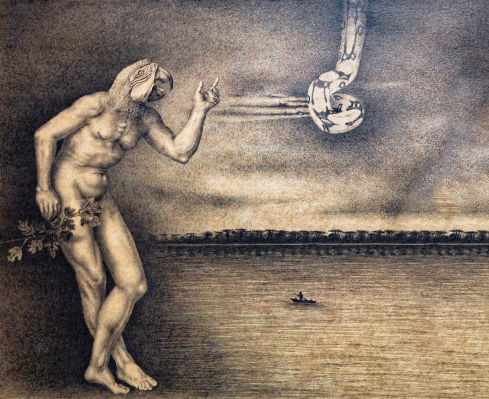
Miguel Vilca – “El origen del mito.” En el umbral entre el agua y el cielo, un ser entre mundos alza la mano hacia la serpiente de la creación.
Epílogo
Un Río — Dos Corrientes
Ambas corrientes de este arte extraordinario tienen su origen en la inmensa cuenca del Amazonas — un cosmos único, armónico y paradójico a la vez, que marca profundamente la vida de todos sus habitantes.
En el amplio panorama del arte amazónico contemporáneo, ambas tendencias se encuentran y dialogan.
Surgen de fuentes culturales y experiencias existenciales distintas.
Sin embargo, su fuerza motriz — su movens artístico — no reside en el origen de quienes las crean, sino en su actitud y en su marco de referencia.
Ambas comparten temas, motivos y símbolos, y permanecen inseparablemente ligadas a la geografía del Amazonas.
Y es precisamente de esta conexión compartida de donde surge un diálogo que hace visibles las diferencias sin separarlas — un diálogo que convierte la diversidad en energía creadora.
Este artículo está dedicado al arte amazónico contemporáneo y explora sus características, temas y formas de expresión.
Acompaña al texto anterior sobre el arte indígena contemporáneo,
que puede encontrar aquí:
Sobre los términos y su significado.
Los términos utilizados para describir el arte del Amazonas varían y a menudo se entrecruzan. Mientras algunas obras se engloban dentro de la noción más amplia de arte amazónico contemporáneo (o simplemente arte amazónico), muchos creadores indígenas definen su arte específicamente como arte indígena contemporáneo, destacando sus raíces en sus propias tradiciones y cosmovisiones.
En este texto utilizo ambos términos: arte indígena contemporáneo y el más geográficamente específico, arte indígena amazónico. Este doble enfoque busca honrar la autoidentificación de los artistas y situar su obra dentro del paisaje cultural único que la inspira.
Ambos términos se emplean con el mismo respeto. Reconocen que lo que une a estos artistas es mucho más fuerte que lo que los separa: un diálogo creativo entre legado y transformación, entre la memoria del bosque y el mundo contemporáneo.
